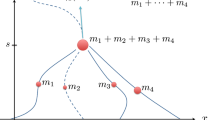Abstract
We examine two point particles interacting via a smooth Lennard-Jones-type potential of finite range on a two-dimensional torus. We find situations under which this system contains a stable, elliptic periodic orbit and hence is not ergodic. This result is in contrast to the case of hard spheres interacting via inelastic collision, which are always ergodic for two particles, are conjectured to be ergodic for arbitrarily many particles, and can never contain elliptic periodic orbits.
Similar content being viewed by others
REFERENCES
D. Szasz, Boltzmann's ergodic hypothesis, a conjecture for the centuries?, Studia Sci. Math. Hung. 32:299-322 (1996).
N. S. Krylov, Works on the Foundation of Statistical Physics (Princeton University Press, Princeton, New Jersey, 1979).
Ya. G. Sinai, On the foundations of the ergodic hypothesis for a dynamical system of statistical mechanics, Dokl. Akad. Nauk. SSSR 153:1261-1264 (1963).
Ya. G. Sinai, Dynamical systems with elastic reflections. Ergodic properties of dispersing billiards, Russ. Math. Surv. 25:137-189 (1970).
Ya. G. Sinai and N. Chernov, Ergodic properties of some systems of two-dimensional disks and three-dimensional balls, Uspekhi Mat. Nauk. 42, No. 3 (255):153-174 (1987).
A. Kramli, N. Simanyi, and D. Szasz, Ergodic properties of semi-dispersing billiards I. Two cylindric scatterers in the 3-D torus, Nonlinearity 2:311-326 (1989).
A. Kramli, N. Simanyi, and D. Szasz, A “transversal” fundamental theorem for semi-dispersing billiards, Commun. Math. Phys. 535-560 (1990).
A. Kramli, N. Simanyi, and D. Szasz, The K-property of three billiard balls, Annals of Mathematics 133:37-72 (1991).
A. Kramli, N. Simanyi, and D. Szasz, The K-property of four billiard balls, Commun. Math. Phys. 144:107-148 (1992).
N. Simanyi and D. Szasz, The Boltzmann-Sinai ergodic hypothesis for hard ball systems, E. Schrödinger Institute Preprint 337 (1996).
D. A. McQuarrie, Statistical Mechanics (Harper & Row, New York, 1976).
D. Turaev and V. Rom-Kedar, Elliptic islands appearing in near-ergodic flows, Non-linearity 11:575-600 (1998).
M. Wojtkowski, Linearly stable orbits in 3 dimensional billiards, Comm. Math. Phys. 129:319-327 (1990).
M. Hermann, lecture at University of Pennsylvania (November 1995).
V. J. Donnay, Elliptic islands in generalized Sinai billiards, Ergod. Th. & Dynam. Sys. 16:975-1010 (1996).
H. Goldstein, Classical Mechanics (Addison-Wesley, London, 1950).
N. Simanyi and M. Wojtkowski, Two-particle billiard system with arbitrary mass ratio, Ergod. Th. & Dynam. Sys. 9:165-171 (1989).
I. Kubo, Perturbed billiard systems, I. The ergodicity of the motion of a particle in a compound central field, Nagoya Math. J. 61:1-57 (1976).
I. Kubo and H. Murata, Perturbed billiard systems, II. Bernoulli properties, Nagoya Math. J. 81:1-25 (1981).
A. Vetier, Sinai billiard in potential field (construction of fibers), P. Révész, ed., Coll. Math. Soc. J. Bolyai 36:1079–1146 (1982).
A. Vetier, Sinai billiard in potential field (absolute continuity), Proc. 3rd Pann. Symp., J. Mogyoródi, I. Vincze, and W. Wertz, eds., 341-351 (1982).
P. R. Baldwin, Soft billiard systems, Physica D 29:321-342 (1988).
A. Knauf, On soft billiard systems, Physica D 36:259-262 1989).
A. Kramli, N. Simanyi, and D. Szasz, Dispersing billiards without focal points on surfaces are ergodic, Commun. Math. Phys. 125:439-457 (1989).
V. J. Donnay and C. Liverani, Potentials on the two-torus for which the Hamiltonian flow is ergodic, Commun. Math. Phys. 135:267-302 (1991).
R. Markarian, Ergodic properties of plane billiards with symmetric potentials, Comm. Math. Phys. 145:435-446 (1992).
L. A. Bunimovich, On the ergodic properties of nowhere dispersing billiards, Comm. Math. Phys. 65:295-312 (1979).
V. I. Arnold, Mathematical Methods of Classical Mechanics (Springer-Verlag, New York, 1980).
A. Katok and B. Hasselblatt, Introduction to the Modern Theory of Dynamical Systems (Cambridge University Press, Cambridge, 1995).
V. Rom-Kedar and D. Turaev, Big islands in dispersing billiard-like potentials, Physica D 130:187-210 (1999).
Author information
Authors and Affiliations
Rights and permissions
About this article
Cite this article
Donnay, V.J. Non-ergodicity of Two Particles Interacting via a Smooth Potential. Journal of Statistical Physics 96, 1021–1048 (1999). https://doi.org/10.1023/A:1004688200435
Issue Date:
DOI: https://doi.org/10.1023/A:1004688200435



